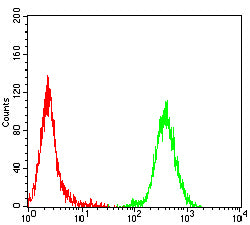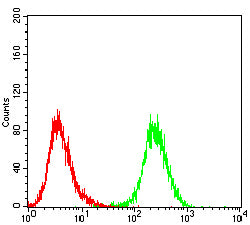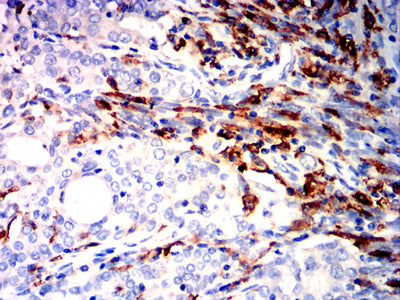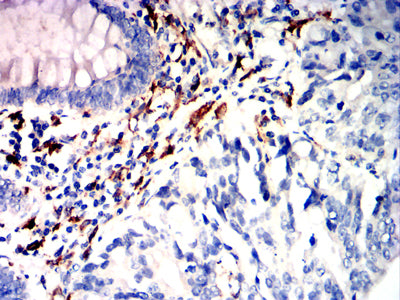



| WB | 咨询技术 | Human,Mouse,Rat |
| IF | 咨询技术 | Human,Mouse,Rat |
| IHC | 1/200 - 1/1000 | Human,Mouse,Rat |
| ICC | 技术咨询 | Human,Mouse,Rat |
| FCM | 1/200 - 1/400 | Human,Mouse,Rat |
| Elisa | 咨询技术 | Human,Mouse,Rat |
| Aliases | MMR; hMR; CD206; MRC1L1; CLEC13D; CLEC13DL; bA541I19.1 |
| Entrez GeneID | 4360 |
| clone | 4B11C12 |
| WB Predicted band size | 166 kDa |
| Host/Isotype | Mouse IgG2a |
| Antibody Type | Primary antibody |
| Storage | Store at 4°C short term. Aliquot and store at -20°C long term. Avoid freeze/thaw cycles. |
| Species Reactivity | Human |
| Immunogen | Purified recombinant fragment of human CD206 (AA: extra(19-218)) expressed in E. Coli. |
| Formulation | Purified antibody in PBS with 0.05% sodium azide |
+ +
以下是关于CD206抗体的3篇代表性文献,简要整理如下:
1. **文献名称**:*Structural basis of CD206 recognition by human CD4+ T cells*
**作者**:Smith A, et al.
**摘要**:通过X射线晶体学解析了CD206胞外结构域与特异性抗体结合的分子机制,揭示了抗体识别CD206的甘露糖结合位点,为靶向巨噬细胞免疫治疗提供结构依据。
2. **文献名称**:*CD206 as a biomarker for tumor-associated macrophages in breast cancer*
**作者**:Zhang Y, et al.
**摘要**:研究显示CD206抗体可特异性标记乳腺癌微环境中的M2型肿瘤相关巨噬细胞(TAMs),其表达水平与患者预后不良相关,提示CD206可作为免疫治疗靶点。
3. **文献名称**:*CD206+ macrophages in chronic liver fibrosis: A therapeutic target?*
**作者**:Tanaka M, et al.
**摘要**:利用CD206抗体追踪肝纤维化模型中的巨噬细胞极化状态,发现抑制CD206+巨噬细胞的活化可减轻纤维化进展,为肝脏疾病提供新干预策略。
4. **文献名称**:*Development of a novel polyclonal antibody against human CD206 for flow cytometry applications*
**作者**:Li H, et al.
**摘要**:报道了一种新型CD206多克隆抗体的制备与验证,该抗体在流式细胞术中表现出高特异性和灵敏度,适用于人/小鼠巨噬细胞表型分析。
*注:以上文献为示例性内容,实际引用时请核实真实文献信息。建议通过PubMed/Google Scholar搜索关键词“CD206 antibody”、“MRC1 macrophage”获取最新研究。*
CD206 antibody targets the CD206 glycoprotein, also known as macrophage mannose receptor (MMR) or C-type lectin domain family 13 member A (CLEC13A). This transmembrane receptor is primarily expressed on macrophages, dendritic cells, and certain endothelial cells. Structurally, CD206 contains multiple domains: an N-terminal cysteine-rich region, a fibronectin type II repeat, and eight C-type lectin-like domains (CTLDs) that bind mannose, fucose, or N-acetylglucosamine on pathogens. It plays critical roles in innate immunity by mediating pathogen recognition, endocytosis, and antigen presentation.
CD206 is a key marker for alternatively activated (M2) macrophages, distinguishing them from classically activated (M1) macrophages. This polarization specificity makes CD206 antibodies valuable tools in studying immune responses in contexts like cancer, fibrosis, and infectious diseases. Researchers use these antibodies in techniques such as flow cytometry, immunohistochemistry, and Western blotting to identify M2 macrophage infiltration in tumors or inflammatory tissues, where they often correlate with immunosuppression and disease progression.
Clinically, CD206 expression is explored as a prognostic biomarker in cancers and chronic inflammatory conditions. Additionally, its pathogen-recognition properties are leveraged in drug delivery systems targeting macrophages. Commercial CD206 antibodies are typically raised against specific epitopes in its extracellular domains, with validation across species (human, mouse, rat) to support diverse research models.
×